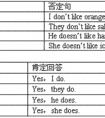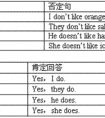用所给动词的适当形式填空。1. You can ______ me Michael.2. I can ______ a little English.3. ______ you ______ to buy a new cap?4. May I ______ Chinese with-七年级英语
Some water is in the glass
(2) 单个的可数名词做主语:
The girl is Chinese. My watch is on the dresser.
(3) He ,she , it 等代词单个做主语:
He is in the tree. She likes her family very much.
(4) 单个的人名,地名或称呼作主语:
Mary is a doctor. Uncle Li speaks a little English.
Changchun is a beautiful city.
(5) 指示代词this, that 等作主语:
This is a pear. That is an apple .
(6) Everyone, everything ,something, nobody, nothing.等不定代词作主语时
Is everyone here today? Everything is ok .
(7)单个数字作主语时:
”8” is a good number in China.
动词单数第三人称形式的一般现在时的句子的否定句、疑问句及特殊疑问句。 <?xml:namespace prefix = "o" ns = "urn:schemas-microsoft-com:office:office" />
否定句:
在主语的后面实义动词前加doesn’t(注意实义动词应恢复原形。)
主语(单三)+doesn’ + 动词原形+其他
Jim likes football变否定: Jim doesn’t like football
He has lunch at school. 变否定:He doesn’t have lunch at school.
一般疑问句及答语,在句子前面加助动词does. 实义动词恢复原形
Does +主语(单三)+ 动词原形+其他
Does your father work ? Yes, he does. /No, he doesn’t
特殊疑问句:特殊疑问词+一般疑问句
特殊疑问词+ does +主语(单三)+ 动词原形+其他
Where does a bird live ?
How does she go to school?
考点名称:助动词的单数第三人称形式
- 助动词的单三形式:
助动词
be
do
have
shall
will
单三形式
is
does
has
shall
will
考点名称:助动词
- 助动词:
协助主要动词构成谓语动词词组的词叫助动词。
助动词是语法功能词,自身没有词义,不可单独使用,只能和别的动词一起构成谓语,表示时态、语态、语气等,或表示疑问或否定。
常用的助动词有:
be,do,does,did,have,has,shall,will,would等。 常见助动词用法:
have的用法:
have作助动词
形式:
主要变化形式:have,has,had
动名词/现在分词:having
1)have +过去分词,构成完成时态,例:
He has left for London. 他已去了伦敦。
By the end of last month, they had finished half of their work.
上月末为止,他们已经完成工作的一半。
2)have + been +现在分词,构成完成进行时(现在完成时),例:
I have been studying English for ten years.我一直在学英语,已达十年之久。
3)have+been +过去分词,构成完成时态的被动语态,例:
English has been taught in China for many years.中国教英语已经多年。
do的用法:
形式
主要变化形式:do,did,done
动名词/现在分词:doing
1) 构成一般疑问句,例如:
Do you want to pass the CET?你想通过大学英语测试吗?
Did you study German? 你们学过德语吗?
2)do + not 构成否定句,例如:
I do not want to be criticized.我不想挨批评。
He doesn't like to study.他不想学习。
In the past, many students did not know the importance of English.过去,好多学生不知道英语的重要性。
3) 构成否定祈使句,例如:
Don't go there. 不要去那里。
Don't be so absent-minded. 不要这么心不在焉。
说明: 构成否定祈使句只用do,。
4)放在动词原形前,加强该动词的语气,例如:
Do come to my birthday party please.请一定来参加我的生日宴会。
I did go there. 我确实去那儿了。
I do miss you. 我确实想你。我真想你了!
5)用于倒装句,例如:
Never did I hear of such a thing.
我从未听说过这样的事情。
Only when we begin our college life do we realize the importance of English.
只有在开始大学生活时我们才认识到英语的重要性。
说明: 引导此类倒装句的副词有never, seldom, rarely, little, only, so, well等。
6)用作代替动词,例如:
Do you like Beijing? 你喜欢北京吗?
Yes,I do.是的,喜欢。(do用作代动词,代替like Beijing.)
He knows how to drive a car, doesn't he?他知道如何开车,对吧?
may和can:
1) may用来表示许可
2)may用于所有人称的现在时及将来时句子中。
3)might用于所有人称的过去时及条件句中。
否定形式:may not/mayn't,might not/mightn't
疑问式:may I?might I?等
否定疑问式:may I not?/mayn't I?等
表示许可的may的其他形式可用allow,be allowed的相应形式代替。
4)may后面接不带to的不定式(即动词原形)。
5)can用来表示许可
6)can用于所有人称的现在时及将来时的句子中。
7)could用于所有人称的过去时及条件句中。
否定式:can not/can't,could not/could't
疑问式:can I?could I?等。
否定疑问式:can I not?/can't I?could I not?/couldn't I?等。
表示许可的can的其他形式可用于allow,be allowde的相应形式代替。
can与不带to的不定式连用。
shall和will的用法:
- 最新内容
- 相关内容
- 网友推荐
- 图文推荐
| [家长教育] 孩子为什么会和父母感情疏离? (2019-07-14) |
| [教师分享] 给远方姐姐的一封信 (2018-11-07) |
| [教师分享] 伸缩门 (2018-11-07) |
| [教师分享] 回家乡 (2018-11-07) |
| [教师分享] 是风味也是人间 (2018-11-07) |
| [教师分享] 一句格言的启示 (2018-11-07) |
| [教师分享] 无规矩不成方圆 (2018-11-07) |
| [教师分享] 第十届全国教育名家论坛有感(二) (2018-11-07) |
| [教师分享] 贪玩的小狗 (2018-11-07) |
| [教师分享] 未命名文章 (2018-11-07) |


![How much does it ______ to fly from Yancheng to Hainan Island?[ ]A. cost B. payC. spend D. take-七年级英语](http://www.00-edu.com/d/file/ks/4/2/shiyidongci/2020-01-05/small7dcf2f05998de63e10cc3629787031c81578210087.png)

![He always _____TV in the evening. He _____ listening to the radio. [ ]A. watch, don't like B. watches, doesn't like C. watching, don't like D. watch, do-七年级英语](http://www.00-edu.com/d/file/ks/4/2/shiyidongci/2020-01-05/small45d599b4a60b84e61cec210bfbf051f51578214524.png)
![I'd rather ___ to the Mcdonald's Restaurant because I like to listen to quiet music.[ ]A. to go B. going C. go D. went-八年级英语](http://www.00-edu.com/d/file/ks/4/2/shiyidongci/2020-01-05/small1767bba1727fef2c035c53dcbd9bc20e1578209517.png)
